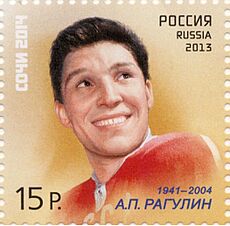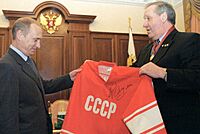Alexander Ragulin facts for kids
Quick facts for kids Alexander Ragulin |
|||
|---|---|---|---|

Alexander Ragulin on a 2013 Russian stamp from the series "Sports Legends"
|
|||
| Born | 5 May 1941 Moscow, Russian SFSR, Soviet Union |
||
| Died | 17 November 2004 (aged 63) Moscow, Russia |
||
| Height | 6 ft 1 in (185 cm) | ||
| Weight | 231 lb (105 kg; 16 st 7 lb) | ||
| Played for | CSKA Moscow Khimik Voskresensk |
||
| National team | |||
 Ragulin presents his signed uniform to President Vladimir Putin in 2001 |
||
| Medal record | ||
|---|---|---|
| Representing |
||
| Olympic Games | ||
| Gold | 1964 Innsbruck | |
| Gold | 1968 Grenoble | |
| Gold | 1972 Sapporo | |
| World Championships | ||
| Bronze | 1961 Geneva | |
| Gold | 1963 Stockholm | |
| Gold | 1964 Innsbruck | |
| Gold | 1965 Tampere | |
| Gold | 1966 Ljubljana | |
| Gold | 1967 Vienna | |
| Gold | 1968 Grenoble | |
| Gold | 1969 Stockholm | |
| Gold | 1970 Stockholm | |
| Gold | 1971 Bern | |
| Silver | 1972 Prague | |
| Gold | 1973 Moscow | |
Alexander Pavlovich "Rags" Ragulin (born May 5, 1941 – died November 17, 2004) was a famous Russian ice hockey player. Many people think he was one of the best defensemen (a player who helps protect the goal) in the history of Soviet ice hockey. He won an amazing three Olympic gold medals and ten world championships! He was even added to the IIHF Hall of Fame in 1997, which is a special place for the greatest hockey players.
Contents
A Hockey Legend: Alexander Ragulin's Career
Alexander Ragulin, often called "Rags," was a truly incredible ice hockey player. He was known for his strong defense and his ability to help his team win many important games. His career was full of victories and achievements that made him a hero in the world of hockey.
Starting Out in Hockey
Ragulin began playing ice hockey in 1957. He started his training with a team called Khimik Voskresensk. It was a family affair, as his brothers, Anatoly and Mikhail, also played on the same team. This early experience helped him develop his skills and passion for the sport.
Joining CSKA Moscow
In 1962, Alexander Ragulin moved to a very powerful team, CSKA Moscow. He played for this team until he retired in 1973. With CSKA Moscow, he achieved huge success. He helped them win nine Soviet titles, which means they were the best team in the Soviet Union many times. He also won five European Champions Cups with CSKA.
Playing for the Soviet National Team
Ragulin was a key player for the Soviet national team for 13 years. During this time, he played in 239 matches and scored 29 goals. His time with the national team was marked by incredible success.
- He won three Olympic gold medals, making him an Olympic champion multiple times.
- He also won ten gold medals at the World Championships.
- He earned nine gold and three silver medals at the European Championships.
- In 1966, he was even named the best defenseman at the World Championships.
The Summit Series
In 1972, Ragulin took part in a very famous event called the Summit Series. This was a special eight-game series between the Soviet Union and Canada. It was a chance for the best players from both countries to compete against each other. Ragulin played in six of these exciting games.
After Retirement
After he stopped playing professional hockey, Ragulin continued to be involved in the sport. He coached a team called SKA Novosibirsk. He also worked with young players at the CSKA Moscow sports school, helping to train the next generation of hockey stars.
Honors and Recognition
Alexander Ragulin's amazing career earned him many honors:
- In 1997, he was inducted into the IIHF Hall of Fame. This is a special place that honors the greatest ice hockey players from around the world.
- In 2001, he received the Olympic Order in Silver. This award recognizes people who have made outstanding contributions to the Olympic movement.
Alexander Ragulin is remembered as one of the most important figures in ice hockey history, especially for his strong defense and leadership on the ice.

